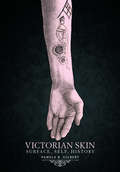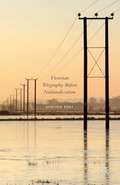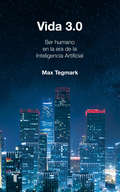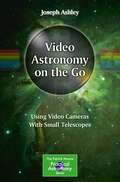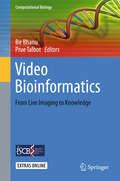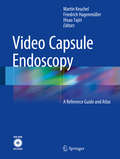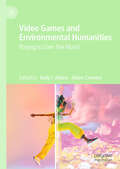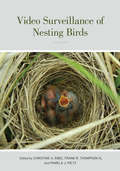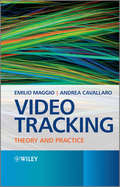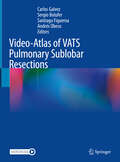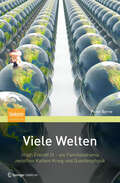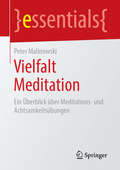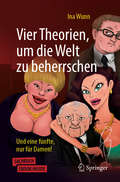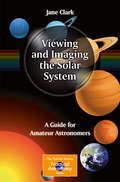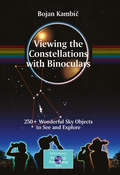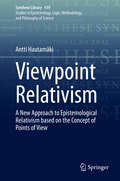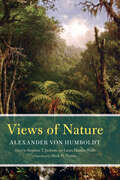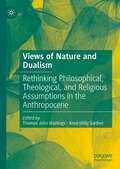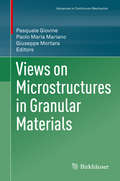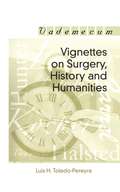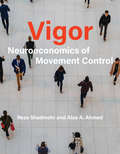- Table View
- List View
Victorian Skin: Surface, Self, History
by Pamela K. GilbertIn Victorian Skin, Pamela K. Gilbert uses literary, philosophical, medical, and scientific discourses about skin to trace the development of a broader discussion of what it meant to be human in the nineteenth century. Where is subjectivity located? How do we communicate with and understand each other's feelings? How does our surface, which contains us and presents us to others, function and what does it signify? As Gilbert shows, for Victorians, the skin was a text to be read. Nineteenth-century scientific and philosophical perspectives had reconfigured the purpose and meaning of this organ as more than a wrapping and instead a membrane integral to the generation of the self. Victorian writers embraced this complex perspective on skin even as sanitary writings focused on the surface of the body as a dangerous point of contact between self and others. Drawing on novels and stories by Dickens, Collins, Hardy, and Wilde, among others, along with their French contemporaries and precursors among the eighteenth-century Scottish thinkers and German idealists, Gilbert examines the understandings and representations of skin in four categories: as a surface for the sensing and expressive self; as a permeable boundary; as an alienable substance; and as the site of inherent and inscribed properties. At the same time, Gilbert connects the ways in which Victorians "read" skin to the way in which Victorian readers (and subsequent literary critics) read works of literature and historical events (especially the French Revolution.) From blushing and flaying to scarring and tattooing, Victorian Skin tracks the fraught relationship between ourselves and our skin.
Victorian Telegraphy Before Nationalization
by Simone FariThis study offers an analysis of the technological and entrepreneurial features of the Victorian telegraph service, together with the companies which ran it until nationalization in 1869. It shows a historical reconstruction mainly based on original and unedited documents belonging to a variety of archives.
Vida 3.0
by Max Tegmark¿Cómo afectará la inteligencia artificial al crimen, a la guerra, a la justicia, al trabajo, a la sociedad y al sentido de nuestras vidas? Bienvenidos a la conversación más importante de nuestro tiempo. ¿Cómo afectará la inteligencia artificial al crimen, a la guerra, a la justicia, al trabajo, a la sociedad y al sentido de nuestras vidas? ¿Es posible que las máquinas nos dejen fuera de juego, remplazando a los humanos en el mercado laboral e incluso en otros ámbitos? ¿La inteligencia artificial proveerá mejoras sin precedente a nuestras vidas o nos dará más poder del que podemos manejar? Muchas de las cuestiones más fundamentales de la actualidad están íntimamente relacionadas con el aumento de la inteligencia artificial. Max Tegmark no se asusta ante la gama completa de puntos de vista o ante los temas más controvertidos, desde la superinteligencia hasta el significado, la conciencia y los límites físicos últimos de la vida en el cosmos. En Vida 3.0, clarifica los conceptos clave necesarios para hablar de inteligencia artificial al tiempo que ayuda a entender la importancia de las cuestiones clave, aquellas que la humanidad tendrá que abordar en las próximas décadas. Reseñas:«Todos nosotros, no solo científicos, industriales y generales, deberíamos preguntarnos qué puede hacerse ahora para aumentar las posibilidades de cosechar los beneficios de la IA futura y evitar sus riesgos. Esta es la conversación más importante de nuestro tiempo, y con este estimulante libro Tegmark te ayudará a participar en ella.»Stephen Hawking «Enriquecedor y visionario. Todo el mundo debería leerlo.»The Times «Tegmark explica con brillantez numerosos conceptos del terreno de la informática al de la cosmología, escribe con modestia y sutileza intelectual, le ofrece al lector el importante servicio de definir sus términos con claridad, y con razón rinde homenaje a las mentes creativas de los escritores de ciencia ficción que, por supuesto, abordaron este tipo de preguntas hace más de medio siglo.»Steven Poole, The Telegraph «Original, accesible y provocador. Tegmark ilumina las numerosas facetas de la inteligencia artificial. Disfruten del viaje y saldrán del otro extremo con una mejor apreciación de adónde podría llevarnos la tecnología en los próximos años.»Science «Una guía convincente por los retos y dilemas en nuestra búsqueda de un gran futuro de la vida, la inteligencia y la consciencia, en la Tierra y más allá de esta.»Elon Musk Estimulante. La discusión inteligente y desenfrenada de Tegmark conduce a fascinantes especulaciones sobre civilizaciones basadas en la inteligencia artificial que abarcan galaxias y eones. Absorbente.»Publishers Weekly
Vida 3.0
by Max Tegmark¿Cómo afectará la inteligencia artificial al crimen, a la guerra, a la justicia, al trabajo, a la sociedad y al sentido de nuestras vidas? Bienvenidos a la conversación más importante de nuestro tiempo. ¿Cómo afectará la inteligencia artificial al crimen, a la guerra, a la justicia, al trabajo, a la sociedad y al sentido de nuestras vidas? ¿Es posible que las máquinas nos dejen fuera de juego, remplazando a los humanos en el mercado laboral e incluso en otros ámbitos? ¿La inteligencia artificial proveerá mejoras sin precedente a nuestras vidas o nos dará más poder del que podemos manejar? Muchas de las cuestiones más fundamentales de la actualidad están íntimamente relacionadas con el aumento de la inteligencia artificial. Max Tegmark no se asusta ante la gama completa de puntos de vista o ante los temas más controvertidos, desde la superinteligencia hasta el significado, la conciencia y los límites físicos últimos de la vida en el cosmos. En Vida 3.0, clarifica los conceptos clave necesarios para hablar de inteligencia artificial al tiempo que ayuda a entender la importancia de las cuestiones clave, aquellas que la humanidad tendrá que abordar en las próximas décadas. Reseñas:«Todos nosotros, no solo científicos, industriales y generales, deberíamos preguntarnos qué puede hacerse ahora para aumentar las posibilidades de cosechar los beneficios de la IA futura y evitar sus riesgos. Esta es la conversación más importante de nuestro tiempo, y con este estimulante libro Tegmark te ayudará a participar en ella.»Stephen Hawking «Enriquecedor y visionario. Todo el mundo debería leerlo.»The Times «Tegmark explica con brillantez numerosos conceptos del terreno de la informática al de la cosmología, escribe con modestia y sutileza intelectual, le ofrece al lector el importante servicio de definir sus términos con claridad, y con razón rinde homenaje a las mentes creativas de los escritores de ciencia ficción que, por supuesto, abordaron este tipo de preguntas hace más de medio siglo.»Steven Poole, The Telegraph «Original, accesible y provocador. Tegmark ilumina las numerosas facetas de la inteligencia artificial. Disfruten del viaje y saldrán del otro extremo con una mejor apreciación de adónde podría llevarnos la tecnología en los próximos años.»Science «Una guía convincente por los retos y dilemas en nuestra búsqueda de un gran futuro de la vida, la inteligencia y la consciencia, en la Tierra y más allá de esta.»Elon Musk Estimulante. La discusión inteligente y desenfrenada de Tegmark conduce a fascinantes especulaciones sobre civilizaciones basadas en la inteligencia artificial que abarcan galaxias y eones. Absorbente.»Publishers Weekly
Video Astronomy on the Go
by Joseph AshleyAuthor Joseph Ashley explains video astronomy's many benefits in this comprehensive reference guide for amateurs. Video astronomy offers a wonderful way to see objects in far greater detail than is possible through an eyepiece, and the ability to use the modern, entry-level video camera to image deep space objects is a wonderful development for urban astronomers in particular, as it helps sidestep the issue of light pollution. The author addresses both the positive attributes of these cameras for deep space imaging as well as the limitations, such as amp glow. The equipment needed for imaging as well as how it is configured is identified with hook-up diagrams and photographs. Imaging techniques are discussed together with image processing (stacking and image enhancement). Video astronomy has evolved to offer great results and great ease of use, and both novices and more experienced amateurs can use this book to find the set-up that works best for them. Flexible and portable, they open up a whole new way of seeing space.
Video Bioinformatics
by Bir Bhanu Prue TalbotThe advances of live cell video imaging and high-throughput technologies for functional and chemical genomics provide unprecedented opportunities to understand how biological processes work in subcellular and multicellular systems. The interdisciplinary research field of Video Bioinformatics is defined by Bir Bhanu as the automated processing, analysis, understanding, data mining, visualization, query-based retrieval/storage of biological spatiotemporal events/data and knowledge extracted from dynamic images and microscopic videos. Video bioinformatics attempts to provide a deeper understanding of continuous and dynamic life processes. Genome sequences alone lack spatial and temporal information, and video imaging of specific molecules and their spatiotemporal interactions, using a range of imaging methods, are essential to understand how genomes create cells, how cells constitute organisms, and how errant cells cause disease. The book examines interdisciplinary research issues and challenges with examples that deal with organismal dynamics, intercellular and tissue dynamics, intracellular dynamics, protein movement, cell signaling and software and databases for video bioinformatics. Topics and Features * Covers a set of biological problems, their significance, live-imaging experiments, theory and computational methods, quantifiable experimental results and discussion of results. * Provides automated methods for analyzing mild traumatic brain injury over time, identifying injury dynamics after neonatal hypoxia-ischemia and visualizing cortical tissue changes during seizure activity as examples of organismal dynamics * Describes techniques for quantifying the dynamics of human embryonic stem cells with examples of cell detection/segmentation, spreading and other dynamic behaviors which are important for characterizing stem cell health * Examines and quantifies dynamic processes in plant and fungal systems such as cell trafficking, growth of pollen tubes in model systems such as Neurospora Crassa and Arabidopsis * Discusses the dynamics of intracellular molecules for DNA repair and the regulation of cofilin transport using video analysis * Discusses software, system and database aspects of video bioinformatics by providing examples of 5D cell tracking by FARSIGHT open source toolkit, a survey on available databases and software, biological processes for non-verbal communications and identification and retrieval of moth images This unique text will be of great interest to researchers and graduate students of Electrical Engineering, Computer Science, Bioengineering, Cell Biology, Toxicology, Genetics, Genomics, Bioinformatics, Computer Vision and Pattern Recognition, Medical Image Analysis, and Cell Molecular and Developmental Biology. The large number of example applications will also appeal to application scientists and engineers. Dr. Bir Bhanu is Distinguished Professor of Electrical & C omputer Engineering, Interim Chair of the Department of Bioengineering, Cooperative Professor of Computer Science & Engineering, and Mechanical Engineering and the Director of the Center for Research in Intelligent Systems, at the University of California, Riverside, California, USA. Dr. Prue Talbot is Professor of Cell Biology & Neuroscience and Director of the Stem Cell Center and Core at the University of California Riverside, California, USA.
Video Capsule Endoscopy: A Reference Guide and Atlas
by Martin Keuchel, Friedrich Hagenmüller and Hisao TajiriThis book is simultaneously a superb atlas and a detailed guide to all aspects of video capsule endoscopy. History, technique, performance, reading, indications, contraindications, outcomes, complications and alternative methods are described systematically by a large panel of experts. In addition, the full range of small bowel diseases, from the common to the rare, are described and illustrated using a unique and exhaustive collection of capsule endoscopy images that are accompanied by corresponding images of enteroscopy, surgery, radiology and histology whenever possible. The newest technology of colon capsule endoscopy is included and exciting potential future developments are also considered. This book will be indispensable for all who use the technique or are considering establishing a video capsule endoscopy service.
Video Games and Environmental Humanities: Playing to Save The World
by Adam Crowley Kelly I. AlianoThis edited collection investigates topics related to environmental humanities through their inclusion, exploration, or critique in contemporary video games. It focuses on how video games are a site for creating and interacting within environments, with analysis that showcases how environments are shaped within video games as well as serve as a reflection of our real world. This crossroad between the virtual and the real allows us to consider the ways in which the concepts, theories, and issues facing our real-world environment can be understood and studied through video games, particularly via the power of interactive play to teach. This book looks into how video games might empower their players to make real-world change through their immersive environments. Finally, the volume offers a consideration of ecological crises through an exploration of post-apocalyptic narratives in a wide variety of video games. This close textual analysis of video game narratives and play structures allows insight into how and why such stories were crafted and explores the various intersections between these fictional play environments and the conditions of our real world.
Video Surveillance of Nesting Birds
by Frank Richard Thompson III Christine Ann Ribic Pamela Jo PietzDeclining bird populations, especially those that breed in North American grasslands, have stimulated extensive research on factors that affect nest failure and reduced reproductive success. Until now, this research has been hampered by the difficulties inherent in observing nest activities. Video Surveillance of Nesting Birds highlights the use of miniature video cameras and recording equipment yielding new important and some unanticipated insights into breeding bird biology, including previously undocumented observations of hatching, incubation, fledging, diurnal and nocturnal activity patterns, predator identification, predator-prey interactions, and cause-specific rates of nest loss. This seminal contribution to bird reproductive biology uses tools capable of generating astonishing results with the potential for fresh insights into bird conservation, management, and theory.
Video Tracking
by Andrea Cavallaro Emilio MaggioVideo Tracking provides a comprehensive treatment of the fundamental aspects of algorithm and application development for the task of estimating, over time, the position of objects of interest seen through cameras. Starting from the general problem definition and a review of existing and emerging video tracking applications, the book discusses popular methods, such as those based on correlation and gradient-descent. Using practical examples, the reader is introduced to the advantages and limitations of deterministic approaches, and is then guided toward more advanced video tracking solutions, such as those based on the Bayes' recursive framework and on Random Finite Sets.Key features:Discusses the design choices and implementation issues required to turn the underlying mathematical models into a real-world effective tracking systems. Provides block diagrams and simil-code implementation of the algorithms. Reviews methods to evaluate the performance of video trackers - this is identified as a major problem by end-users. The book aims to help researchers and practitioners develop techniques and solutions based on the potential of video tracking applications. The design methodologies discussed throughout the book provide guidelines for developers in the industry working on vision-based applications. The book may also serve as a reference for engineering and computer science graduate students involved in vision, robotics, human-computer interaction, smart environments and virtual reality programmes
Video Tracking: Theory and Practice
by Andrea Cavallaro Emilio MaggioVideo Tracking provides a comprehensive treatment of the fundamental aspects of algorithm and application development for the task of estimating, over time, the position of objects of interest seen through cameras. Starting from the general problem definition and a review of existing and emerging video tracking applications, the book discusses popular methods, such as those based on correlation and gradient-descent. Using practical examples, the reader is introduced to the advantages and limitations of deterministic approaches, and is then guided toward more advanced video tracking solutions, such as those based on the Bayes’ recursive framework and on Random Finite Sets. Key features: Discusses the design choices and implementation issues required to turn the underlying mathematical models into a real-world effective tracking systems. Provides block diagrams and simil-code implementation of the algorithms. Reviews methods to evaluate the performance of video trackers – this is identified as a major problem by end-users. The book aims to help researchers and practitioners develop techniques and solutions based on the potential of video tracking applications. The design methodologies discussed throughout the book provide guidelines for developers in the industry working on vision-based applications. The book may also serve as a reference for engineering and computer science graduate students involved in vision, robotics, human-computer interaction, smart environments and virtual reality programmes
Video-Atlas of VATS Pulmonary Sublobar Resections
by Carlos Galvez Sergio Bolufer Santiago Figueroa Andrés ObesoThe Video-Atlas of Pulmonary Sublobar Resections aims to be a reference multimedia book for Thoracic Surgeons. Mainly focused on operative technical aspects, each individual segmentectomy and many combinations are described. Each chapter opens with anatomical 3D reconstructions of the segment and its bronchoscopic anatomy. Then, the main steps for performing the procedure, that are illustrated in high-definition (HD) video-clips and figures, are described. Expert authors highlight specifical tips & tricks for succesfully performing the resection, and include anatomical variations that also illustrate with HD video-clips.This illustrated guide provides thoracic surgeons with an incredibly useful tool for learning and improving their technique in sublobar resections.Videos and more: Download the free Springer Multimedia App - Scan dedicated images in this book to stream videos or access and download supplementary material.
Viele Welten
by Peter ByrnePeter Byrne erzählt die Lebensgeschichte von Hugh Everett III (1930-1982), dessen Theorie der multiplen Universen die Physik und Philosophie entscheidend beeinflusst hat. Neben seiner berühmten Interpretation der Quantenmechanik verfasste Everett eine klassische Arbeit zur Spieltheorie, entwickelte wegweisende Computeralgorithmen und leistete Pionierarbeit auf dem Gebiet der Künstlichen Intelligenz. Diesem anschaulichen Porträt liegen bisher unveröffentlichte Schriften Everetts zugrunde sowie Interviews mit Freunden, Kollegen und Verwandten.
Vielfalt Meditation: Ein Überblick Über Meditations- Und Achtsamkeitsübungen (Essentials)
by Peter MalinowskiDieses essential bietet einen Überblick über Meditationsrichtungen, -programme und -techniken und führt die wichtigsten Begriffe und Definitionen ein. Peter Malinowski entwirrt die Vielfalt unterschiedlicher Meditationsangebote und vermittelt ein grundlegendes Verständnis von Meditation und Achtsamkeit. Der Leser bekommt einen Leitfaden zur Einteilung von Meditationsübungen, verbunden mit dem Handwerkszeug, um unterschiedliche Angebote sinnvoll unterscheiden zu können. Zudem werden die wichtigsten Erklärungsansätze zur Wirkung von Meditation eingeführt.
Vier Theorien, um die Welt zu beherrschen: Und eine fünfte, nur für Damen!
by Ina WunnWie kommt man gesellschaftlich ganz nach oben? Man kämpft um Macht und Anerkennung und möchte um jeden Preis Aufmerksamkeit erregen. Dabei stellt sich die Frage: Ist das wirklich so einfach und wenn ja, wo fange ich an?Gibt es einen Dresscode, der mich als Mitglied der herrschenden Klasse auszeichnet? Hilft es gar, wenn Frauen Miniröcke und tiefe Ausschnitte tragen? Läuft es etwa darauf hinaus, dass sich meine egoistische Überlebensmaschine mit ebenso egoistischen und möglichst erfolgreichen Genen zusammentut? Geht es in letzter Konsequenz nur um Paarung, um die Alphastellung und damit um einen bevorzugten Platz auf der Mating-Liste?Über all das haben sich Generationen von Biologen, Verhaltensforschern und zuletzt auch Gesellschaftswissenschaftlern Gedanken gemacht. Aber erst, wenn man vier bahnbrechende und eigentlich ganz simple Theorien (egoistisches Gen, Ritual, System und Habitus) in einen inhaltlichen Zusammenhang bringt, lässt sich das Rätsel um das große Spiel von Liebe und Macht, von Schönheit und Herrschaft, von Aufstieg und Fall durchschauen. Und sollten wir die mit Beispielen aus der Welt der Reichen und Schönen angereicherte Lektüre als Lehrstück auffassen, steht unserem gesellschaftlichen Aufstieg in die herrschende Klasse nichts mehr im Wege!
Viewing and Imaging the Solar System
by Jane ClarkViewing and Imaging the Solar System: A Guide for Amateur Astronomers is for those who want to develop their ability to observe and image Solar System objects, including the planets and moons, the Sun, and comets and asteroids. They might be beginners, or they may have already owned and used an astronomical telescope for a year or more. Newcomers are almost always wowed by sights such as the rings of Saturn and the moons of Jupiter, but have little idea how to find these objects for themselves (with the obvious exceptions of the Sun and Moon). They also need guidance about what equipment, besides a telescope, they will need. This book is written by an expert on the Solar System, who has had a lot of experience with outreach programs, which teach others how to make the most of relatively simple and low-cost equipment. That does not mean that this book is not for serious amateurs. On the contrary, it is designed to show amateur astronomers, in a relatively light-hearted--and math-free way--how to become serious.
Viewing the Constellations with Binoculars
by Bojan KambicViewing the Constellations with Binoculars is a complete guide to practical astronomy, written for beginners, intermediate-level astronomers, and even people who have not yet turned their gaze to the night sky. The required observing equipment to get the full value from this book is no more than a pair of regular 10 x 50 binoculars, but even more can be seen with a small astronomical telescope. This comprehensive introduction to astronomy and practical observing is far more than a guide to what can be seen in the night sky through binoculars. It introduces the reader to some basic (and some not-so-basic) astronomical concepts, and discusses the stars and their evolution, the planets, nebulae, and distant galaxies. There is a guide to selecting and using binoculars for astronomy, as well, as a 'getting ready to observe' section containing invaluable practical hints and tips. The second part of the book is an extraordinarily complete atlas and guide to the night sky down to 30º N (covering all the USA and Europe). It is illustrated with superb and sometimes beautiful amateur astronomical photographs, detailed maps (down to 5th magnitude), descriptions, and data on all astronomical objects of interest.
Viewpoint Relativism: A New Approach to Epistemological Relativism based on the Concept of Points of View (Synthese Library #419)
by Antti HautamäkiThis book offers new insights into truth, knowledge, and reality. It details a unique approach to epistemological relativism based on the concept of points of view. In a point of view, an aspect represents an object for a subject. By applying this concept of points of view, the author develops a consistent and adequate form of relativism, called viewpoint relativism, according to which epistemic questions like “Is X true (or justified or existing)” are viewpoint-dependent. The monograph examines central issues related to epistemological relativism. It analyzes major arguments pro and con from different opinions. The author presents the arguments of well-known philosophers. These include such thinkers as Paul Boghossian, John Dewey, Nelson Goodman, Martin Kusch, C.I. Lewis, John MacFarlane, Hilary Putnam, W.V.O. Quine, Richard Rorty, John Searle, and Ludwig Wittgenstein. In the process, the author deconstructs the standard account of correspondence theory of truth. Viewpoint relativism is a moderate relativism, which is not subjected to standard criticism of extreme relativism. This book argues that knowledge creation presupposes openness to different points of view and their comparison. It also explores the broader implications of viewpoint relativism into current debate about truth in society. The author defends a critical relativism, which accepts pluralism but is critical against all points of view. In the conclusion, he explores the relevance of viewpoint relativism to democracy by showing that the main threat of modern democratic society is not pluralism but absolutism and fundamentalism.
Views of Nature
by Laura Dassow Walls Alexander Von Humboldt translated by Mark W. Person edited by Stephen T. JacksonPurchase of this book includes free trial access to www. million-books. com where you can read more than a million books for free. This is an OCR edition with typos. Excerpt from book: Modern views on the mountain systems of the two American peninsulas. Chains, which have a direction from S. W. to N. E. , in Brazil and in the Atlantic portion of the United States of North America. Depression of the Province of Chiquitos; ridges as watermarks between the Guapor6 and Aguapehi in 15 and 17 south lat. , and between the fluvial districts of the Orinoco and Eio Negro in 2 and 3 north lat. ?pp. 29-31. Continuation of the Andes-chain north of the isthmus of PanamS through the territory of the Aztecs, (where the Popocatepetl, recently ascended by Capt. Stone, rises to an altitude of 17,720 feet, ) and through the Crane and Rocky Mountains. Valuable scientific investigations of Capt. Fremont. The greatest barometric levelling ever accomplished, representing a profile of the ground over 28 of longitude. Culminating point of the route from the coast of the Atlantic to the South Sea. The South Pass southward of the Wind-River Mountains. Swelling of the ground in the Great Basin. Long disputed existence of Lake Timpanogos. Coast-chain, Maritime Alps, Sierra Nevada of California. Volcanic eruptions. Cataracts of the Columbia River?pp. 31-38. General considerations on the contrast between the configuration of the territorial spaces, presented by the two diverging coast-chains, east and west of the central chain, called the Rocky Mountains. Hypsometric constitution of the Eastern Lowland, which is only from 400 to somewhat more than 600 feet above the level of the sea, and of the arid uninhabited plateau of the Great Basin, from 5000 to more than 6000 feet high. Sources of the Mississippi in Lake Istaca according to Nicollet, whose labours are most meritorious. Native land of the Bisons; their ancient domestication in Northern Mexico asserted by Gomara?pp. 38-42. Retrospectiv. .
Views of Nature and Dualism: Rethinking Philosophical, Theological, and Religious Assumptions in the Anthropocene
by Knut-Willy Sæther Thomas John HastingsIn the face of the anthropogenic threats to the singular planetary habitat we share with other human beings and non-human species, humanities scholars feel a renewed sense of urgency 1) to acknowledge the ways our species has funded particular histories of environmental exploitation, alienation, and collapse, 2) to unpack inherited assumptions that impact our views of nature and interspecies relations, and 3) to suggest ways of thinking and acting that seek to repair the damage and promote mutual flourishing for all of earth inhabitants. This volume brings together scholars in philosophy, theology, and religion who take up this urgent ethical task from a broad range of perspectives and locations.
Views on Microstructures in Granular Materials (Advances in Mechanics and Mathematics #44)
by Paolo Maria Mariano Pasquale Giovine Giuseppe MortaraThis contributed volume provides an up-to-date overview of the mechanics of granular materials, ranging from sparse media to soils. With chapters exploring state-of-the-art theoretical, experimental, and applied trends in the study of granular matter in various states, readers will be motivated to learn about the current challenges and potential avenues of exploration in this active area of research. Including a variety of perspectives, this volume will be a valuable reference for audiences in a number of fields. Specific topics covered include:X-ray tomography techniques for analyzing sandEvaluation of effective stress in unsaturated soilsHyper-plasticityWave propagation in granular systemsPartly saturated porous mediaMulti-scale approaches to the dynamics of sparse mediaViews on Microstructures in Granular Materials is an ideal resource for PhD students and researchers in applied mathematics, solid-state physics, civil engineering, and mechanical engineering.
Vignettes on Surgery, History and Humanities
by Luis Horacio Toledo-PereyraThis book introduces writings on the history and philosophy of surgery that previously appeared in the Journal of Investigative Surgery. It attempts to reach students of history in general and those interested in the history and philosophy of surgery in particular.
Vigor: Neuroeconomics of Movement Control
by Reza Shadmehr Alaa A. AhmedAn examination of the link between the vigor with which we move and the value that the brain assigns to the goal of the movement.Why do we reflexively run toward people we love, but only walk toward others? In Vigor, Reza Shadmehr and Alaa Ahmed examine the link between how the brain assigns value to things and how it controls our movements. They find that brain regions thought to be principally involved in decision making also affect movement vigor--and that brain regions thought to be principally responsible for movement also bias patterns of decision making.
Vigyan
by National Council Of Educational Research TrainingThis book prescribed by central board of secondary education, India for the students of class 6th subject science, studying through Hindi medium. This accessible version of the book doesn't leave any part of the book. The book is handy companion of the school and university students desiring to read facts in interesting way. NCERT books are must read for aspirants of competitive and job related examinations in India.
Vigyan
by National Council Of Educational Research TrainingThis book prescribed by central board of secondary education, India for the students of class 7th subject Science, studying through Hindi medium. This accessible version of the book doesn’t leave any part of the book. The book is handy companion of the school and university students desiring to read facts in interesting way. NCERT books are must read for aspirants of competitive and job related examinations in India.
